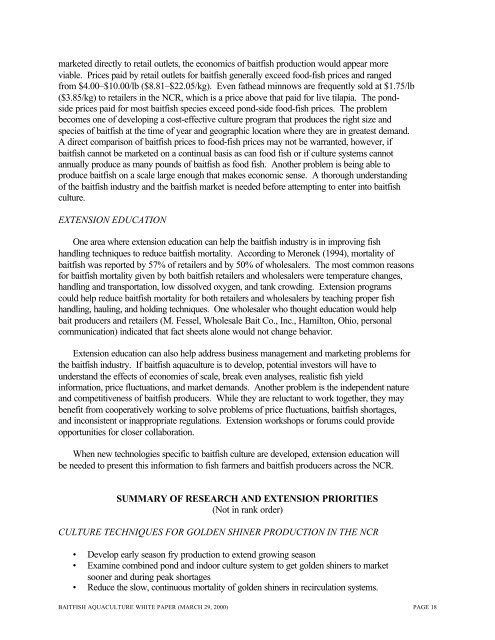a white paper on the status and needs of baitfish ... - NCRAC
a white paper on the status and needs of baitfish ... - NCRAC
a white paper on the status and needs of baitfish ... - NCRAC
You also want an ePaper? Increase the reach of your titles
YUMPU automatically turns print PDFs into web optimized ePapers that Google loves.
marketed directly to retail outlets, <strong>the</strong> ec<strong>on</strong>omics <strong>of</strong> <strong>baitfish</strong> producti<strong>on</strong> would appear more<br />
viable. Prices paid by retail outlets for <strong>baitfish</strong> generally exceed food-fish prices <strong>and</strong> ranged<br />
from $4.00–$10.00/lb ($8.81–$22.05/kg). Even fa<strong>the</strong>ad minnows are frequently sold at $1.75/lb<br />
($3.85/kg) to retailers in <strong>the</strong> NCR, which is a price above that paid for live tilapia. The p<strong>on</strong>dside<br />
prices paid for most <strong>baitfish</strong> species exceed p<strong>on</strong>d-side food-fish prices. The problem<br />
becomes <strong>on</strong>e <strong>of</strong> developing a cost-effective culture program that produces <strong>the</strong> right size <strong>and</strong><br />
species <strong>of</strong> <strong>baitfish</strong> at <strong>the</strong> time <strong>of</strong> year <strong>and</strong> geographic locati<strong>on</strong> where <strong>the</strong>y are in greatest dem<strong>and</strong>.<br />
A direct comparis<strong>on</strong> <strong>of</strong> <strong>baitfish</strong> prices to food-fish prices may not be warranted, however, if<br />
<strong>baitfish</strong> cannot be marketed <strong>on</strong> a c<strong>on</strong>tinual basis as can food fish or if culture systems cannot<br />
annually produce as many pounds <strong>of</strong> <strong>baitfish</strong> as food fish. Ano<strong>the</strong>r problem is being able to<br />
produce <strong>baitfish</strong> <strong>on</strong> a scale large enough that makes ec<strong>on</strong>omic sense. A thorough underst<strong>and</strong>ing<br />
<strong>of</strong> <strong>the</strong> <strong>baitfish</strong> industry <strong>and</strong> <strong>the</strong> <strong>baitfish</strong> market is needed before attempting to enter into <strong>baitfish</strong><br />
culture.<br />
EXTENSION EDUCATION<br />
One area where extensi<strong>on</strong> educati<strong>on</strong> can help <strong>the</strong> <strong>baitfish</strong> industry is in improving fish<br />
h<strong>and</strong>ling techniques to reduce <strong>baitfish</strong> mortality. According to Mer<strong>on</strong>ek (1994), mortality <strong>of</strong><br />
<strong>baitfish</strong> was reported by 57% <strong>of</strong> retailers <strong>and</strong> by 50% <strong>of</strong> wholesalers. The most comm<strong>on</strong> reas<strong>on</strong>s<br />
for <strong>baitfish</strong> mortality given by both <strong>baitfish</strong> retailers <strong>and</strong> wholesalers were temperature changes,<br />
h<strong>and</strong>ling <strong>and</strong> transportati<strong>on</strong>, low dissolved oxygen, <strong>and</strong> tank crowding. Extensi<strong>on</strong> programs<br />
could help reduce <strong>baitfish</strong> mortality for both retailers <strong>and</strong> wholesalers by teaching proper fish<br />
h<strong>and</strong>ling, hauling, <strong>and</strong> holding techniques. One wholesaler who thought educati<strong>on</strong> would help<br />
bait producers <strong>and</strong> retailers (M. Fessel, Wholesale Bait Co., Inc., Hamilt<strong>on</strong>, Ohio, pers<strong>on</strong>al<br />
communicati<strong>on</strong>) indicated that fact sheets al<strong>on</strong>e would not change behavior.<br />
Extensi<strong>on</strong> educati<strong>on</strong> can also help address business management <strong>and</strong> marketing problems for<br />
<strong>the</strong> <strong>baitfish</strong> industry. If <strong>baitfish</strong> aquaculture is to develop, potential investors will have to<br />
underst<strong>and</strong> <strong>the</strong> effects <strong>of</strong> ec<strong>on</strong>omies <strong>of</strong> scale, break even analyses, realistic fish yield<br />
informati<strong>on</strong>, price fluctuati<strong>on</strong>s, <strong>and</strong> market dem<strong>and</strong>s. Ano<strong>the</strong>r problem is <strong>the</strong> independent nature<br />
<strong>and</strong> competitiveness <strong>of</strong> <strong>baitfish</strong> producers. While <strong>the</strong>y are reluctant to work toge<strong>the</strong>r, <strong>the</strong>y may<br />
benefit from cooperatively working to solve problems <strong>of</strong> price fluctuati<strong>on</strong>s, <strong>baitfish</strong> shortages,<br />
<strong>and</strong> inc<strong>on</strong>sistent or inappropriate regulati<strong>on</strong>s. Extensi<strong>on</strong> workshops or forums could provide<br />
opportunities for closer collaborati<strong>on</strong>.<br />
When new technologies specific to <strong>baitfish</strong> culture are developed, extensi<strong>on</strong> educati<strong>on</strong> will<br />
be needed to present this informati<strong>on</strong> to fish farmers <strong>and</strong> <strong>baitfish</strong> producers across <strong>the</strong> NCR.<br />
SUMMARY OF RESEARCH AND EXTENSION PRIORITIES<br />
(Not in rank order)<br />
CULTURE TECHNIQUES FOR GOLDEN SHINER PRODUCTION IN THE NCR<br />
• Develop early seas<strong>on</strong> fry producti<strong>on</strong> to extend growing seas<strong>on</strong><br />
• Examine combined p<strong>on</strong>d <strong>and</strong> indoor culture system to get golden shiners to market<br />
so<strong>on</strong>er <strong>and</strong> during peak shortages<br />
• Reduce <strong>the</strong> slow, c<strong>on</strong>tinuous mortality <strong>of</strong> golden shiners in recirculati<strong>on</strong> systems.<br />
BAITFISH AQUACULTURE WHITE PAPER (MARCH 29, 2000) PAGE 18


